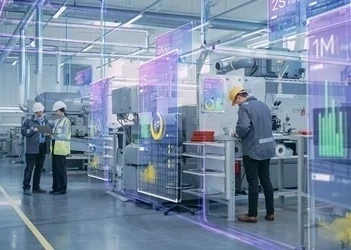3 ways process mining accelerates digital transformation
Process mining provides insights that can lead to powerful improvements in business execution
Add bookmark
Over the last two decades, process mining has evolved from an academic concept into a software-based technology for visualizing, analyzing and optimizing processes. Whereas manual process improvement methods are subject to human bias and error, process mining paints an objective, definitive picture of how processes operate by combining process modeling and data mining.
Process mining provides end-to-end process transparency and visibility, helping organizations compare what they think is happening within their business with what is actually happening. By combining the data and intelligence from process mining with actions and automations, organizations can transform how business operations are executed.
Driven by robotic process automation (RPA) and the adoption of cloud-based enterprise resource planning (ERP) solutions, process mining technology has developed into a powerful enabler of digital transformation.
How process mining accelerates digital transformation
Process mining can support digital transformation in several ways, from streamlining processes and reducing errors to spearheading visualization and automation. Here are three key examples of how process mining aids digital transformation.
Improving core business functions
Process mining can be used to streamline and improve core business functions. In manufacturing, for example, process mining can optimize production lines – detecting inefficiencies in production processes, identifying the root causes of product defects and guiding the implementation of corrective measures, writes author and digital thought leader Suchit Poralla. Likewise, in retail, process mining can help businesses streamline their supply chain and inventory management by analyzing customer buying patterns. “It can also improve customer experience by identifying and rectifying issues in the checkout process,” Poralla adds.
At global healthcare company Sonafi, process mining has been used to reshape the firm’s job change process (anything related to promotion, demotion, lateral moves and general employment contract changes). “The very first step we took was using process mining and machine learning to understand how processes were really executed across the three HR teams: HR strategy, HR operations and a global business services (GBS) organization,” Christian Müller, Sanofi’s head of process intelligence, tells PEX Network. With that knowledge in hand, the company was able to identify bottlenecks, re-engineer processes and, eventually, automate them.
“We worked closely with process owners to redesign the job change process, build process intelligence dashboards tailored to each team’s needs and roll it all out across 70 regions,” Müller says. “It took about a year but, in the end, we reduced cycle time by 87 percent.” What’s more, the median process duration dropped from eight days to less than one and the average process duration shrank from 30 to six days.
Increasing visibility and transparency
Process mining can significantly enhance the visibility and transparency organizations have of their processes and key workflow mechanics. This can prove highly valuable in supporting digital transformation, assisting organizations in visualizing the reality of their business processes.
“They can achieve this through an examination of the electronic footprint incorporated in various IT systems, with the process mining software using the structured data to generate process models that allow for more in-depth comprehension,” writes Jan Brian P. Despi, digital solutions development manager at PwC Philippines. This means that the data logged during the normal process execution would allow for the creation of process maps that incorporate the nuances pertaining to the process, its variants and statistical information, he adds.
“This ensures speedy and cost-effective process delivery that eliminates the need to use interviews to piece together the process. Process maps eliminate the potential for human error and assist in unearthing unusual transactions, as well as the identification of new opportunities that could enhance the operations of an enterprise.”
Identifying the current state of tech processes and where the bottlenecks are in an efficient manner is an important starting point of digital transformation, Mohan Madhurakavi, digital transformation evangelist at Kissflow, tells PEX Network. “Once the bottlenecks are identified, the solution as to why they are occurring and how to solve the issue could form the approach of a design thinking workshop.” Most transformations are being arrived at by trial-and-error methods, but it is important to innovate from the processes businesses currently have, eliminating unnecessary ones and performing checks and balances to eliminate process steps and automate the rest, Madhurakavia says. “A fresh look at the customer experience and journey by design thinking provides a strong foundation for transformational returns.”
Enhancing automation
Process mining can also assist in enhancing automation, especially via the Internet of Things (IoT) and intelligent automation (IA), according to Despi. “Process analytics capabilities allow business users to prioritize IoT and IA solutions alongside their economic impacts through blending operational system data to offer full visibility of the actions that a user takes at every stage of the business process.”
Advanced process mining capabilities can capture real-time information from every other system within an entity and use the information in defining the activity, he adds. “This ensures that the most repeatable patterns within a manual activity are detected and automated, decreasing dependency on labor-intensive processes and allowing robots to function in an efficient and effective manner.”
You’re best off when process mining not only informs the creation of your automation, but also monitors its implementation to continually improve it, adds Process Mining for Dummies. “That’s where automation based on artificial intelligence (AI) and machine learning can really change this game. It yields a system flexible enough to adapt and learn over time.”
Process mining success factors
There are several factors integral to process mining success, with cultural readiness and strategic alignment key elements to consider. “Process mining requires enormous discipline and determination to keep doing work that is done correctly and completed across an organization, but this enables an organization to succeed,” Madhurakavi says. For example, the salesman may not care for which tax category to put in the sales order, but it saves enormous time to the accountants downstream and for the customers. “Additional factors for success include a data-first culture and a culture of innovation and acceptance of mistakes.”
It is important to move beyond insights on how processes are performing — the original intent of process mining — to actions for sustainable businesses improvements, according to thought leaders Lars Reinkemeyer and Tom Davenport. “From a software perspective, moving from insights to action involves targeted apps and problem areas for particular types of processes, such as preserving cash in accounts payable or improving cash flow in accounts receivable (both popular in recessionary economies), improving supplier reliability in procurement and building supply chain resilience, or optimizing inventory levels,” they write.
Executive buy-in and support are important too – recruiting executives sponsors that help to drive adoption of new projects throughout the organization. “A common challenge is when management does not step in to make business decisions that simplify processes, even if it means there are calculated business risks,” Madhurakavi adds. For example, an honor system for claims may be more efficient than checking each claim for its authenticity, even increasing the company’s image with its customers.
Process mining transformation has only just begun and new, innovative technologies are going to play a big role in its successful deployment in businesses. This includes how advances in automated analytics can make process mining easier to use and scalable across the organization. “The goal is to enable a seamless generation of tailored insights and recommendations that drive business value. In a similar vein, several parties want AI to help users identify big improvement levers and support better process execution,” Reinkemeyer and Davenport write.
Other success factors include creating a center of excellence (a dedicated team to accelerating process mining), change management, training and community development of users and real-time integration and data access with connection to feeder systems.
Read PEX Network’s Process mining for digital transformation report to learn how process mining can demystify and optimize complex, interconnected systems.




























